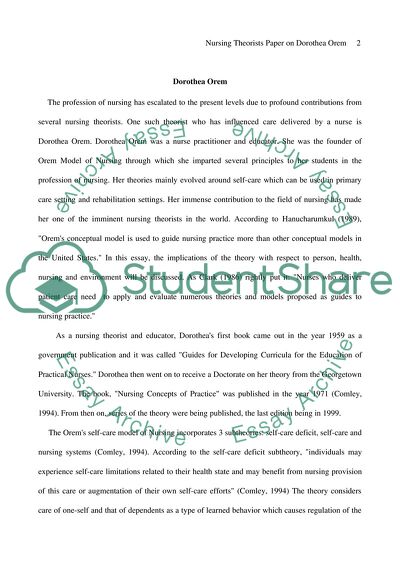
- Home
- Free Samples
- Premium Essays
- Editing Services
- Extra Tools
- Essay Writing Help
- About Us
- Studentshare
- Subjects
- Miscellaneous
- Nursing Theorists Paper on Dorothea Orem
Nursing Theorists Paper on Dorothea Orem - Essay Example

- Subject: Miscellaneous
- Type: Essay
- Level: Masters
- Pages: 4 (1000 words)
- Downloads: 0
- Author: zfadel
Extract of sample "Nursing Theorists Paper on Dorothea Orem"
According to Hanucharumkul (1989), "Orems conceptual model is used to guide nursing practice more than other conceptual models in the United States." In this essay, the implications of the theory with respect to person, health, nursing and environment will be discussed. As Clark (1986) rightly put it: "Nurses who deliver patient care need to apply and evaluate numerous theories and models proposed as guides to nursing practice." As a nursing theorist and educator, Dorotheas first book came out in the year 1959 as a government publication and it was called "Guides for Developing Curricula for the Education of Practical Nurses.
" Dorothea then went on to receive a Doctorate on her theory from the Georgetown University. The book, "Nursing Concepts of Practice" was published in the year 1971 (Comley, 1994). From then on, series of the theory were being published, the last edition being in 1999. The Orems self-care model of Nursing incorporates 3 subtheories: self-care deficit, self-care and nursing systems (Comley, 1994). According to the self-care deficit subtheory, "individuals may experience self-care limitations related to their health state and may benefit from nursing provision of this care or augmentation of their own self-care efforts" (Comley, 1994) The theory considers care of one-self and that of dependents as a type of learned behavior which causes regulation of the structural integrity, development and functioning of the humans.
The nursing system ensues at that point of time when the nurse intervenes with the patient either to prescribe medication or to provide care that is intended to take care of self-care deficit and regulate his or her own capabilities of self-care (Orem, 1985; cited in Comley, 1994). Dorothea Orem considered all human beings as basically biopsychosocial beings with capabilities and willingness to take care of themselves and also be dependent on others. It is through
...Download file to see next pages Read MoreCHECK THESE SAMPLES OF Nursing Theorists Paper on Dorothea Orem
Nursing Concepts: Dorothea Orems Self-Care Deficit Nursing Theory
The Nursing Theory of Dorothea Orem
Dorothy Orem's Nursing Theory
Nursing theorists ab
Importance of Nursing Theory in Nursing Profession
Personal Reflection on Importance of Nursing Theory
Nursing Theories, Roys Adaptation Model
Orems Nursing Theor

- TERMS & CONDITIONS
- PRIVACY POLICY
- COOKIES POLICY